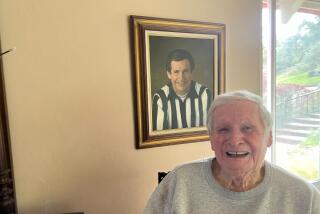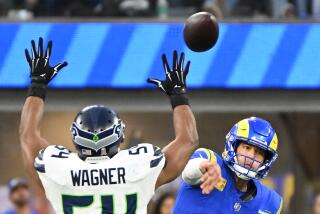Redskins Deny There’s Rein on Marshall’s Skills
WASHINGTON — As running back Jamie Morris, the reserve hero of last Sunday’s 30-7 victory over Dallas, conducted a group interview this week at Redskin Park, Wilber Marshall joined in, extending an invisible microphone toward his teammate, the trace of a smile upon his face.
A short time later, linebacker Marshall was asked by Irv Cross and a camera crew from CBS’ “NFL Today” to be on the receiving end of the questions. The smile faded and Marshall declined, politely telling the visitors to “get one of the guys who likes to talk.”
Marshall does not like to talk.
“There are a lot of guys with something to say; I let my play speak for me,” he said. “I want to be judged by what I do on the field. If I’m doing the job, good. If I’m not, then the team will get rid of me. I just play football. It’s all what I do on the field. That and winning is what I go by.”
Perhaps it’s not entirely coincidental then that Marshall’s best game of the young season (three tackles with his first interception and first sack of the year) came during Washington’s initial victory. Before the Dallas game, the Redskins were 0-2 and Marshall was caught in the swirl of uncertainty that has seemed to engulf the team’s linebacking corps this year.
Neal Olkewicz was cut and re-signed before the season opener. Monte Coleman excelled in that first game against the New York Giants, returning an interception for a touchdown, only to lose his starting position after Week 2 to Ravin Caldwell.
Marshall showed a propensity for losing his helmet during altercations with opposing players and often found himself trudging off the field in passing situations. That Marshall would disagree with opponents was no big surprise but his being substituted for seemed disconcerting to those who noticed his swashbuckling style during four seasons with the Chicago Bears.
“We try to put our best people on the field,” said defensive chief Richie Petitbon, aiming this week to stop the Saints in New Orleans. “Sometimes we take Alvin Walton out, sometimes we take out Dexter Manley. It’s nothing personal against Wilber, that’s just how we do things around here.”
When it comes to Marshall, how the Redskins do things defensively has been a point of contention among fans on the street, if not in the Washington locker room.
Marshall had a solid 1988 season as a new Redskin, making 134 tackles, four sacks and three interceptions. And although this year holds the promise of even better numbers, when his name comes up in barbershops and gymnasiums around town, the question usually follows: Why are the Redskins not cutting him loose like the Bears did?
The askers recall how Marshall opened the 1987 season with three sacks against the Giants in a Monday night matchup of the previous two Super Bowl champions. Or how, in 1986, Marshall scored on a 58-yard interception return in one game and made the spectacular play in another in which he sacked Detroit’s Eric Hipple, stripped him of the ball, picked it up and ran for a touchdown.
Linebackers coach Larry Peccatiello says a check of Marshall’s career statistics proves that last season’s tally is in keeping with his production for the Bears. Not quite true. In 1985, Marshall had six sacks and four interceptions and in ’86 he followed up with 5 1/2 and five.
Marshall made the Pro Bowl after the 1986 season and repeated in ‘87, a year in which he had five sacks but never intercepted a pass. Although his numbers of a year ago compared favorably with other linebackers around the league, some feel he lost a third straight trip to Hawaii because he was muted in the Redskins’ conservative approach.
Petitbon bristles at that line of thinking, arguing that “Wilber gets the chance to do everything that any player does on a football field. Anyone who says otherwise doesn’t know the game.”
Peccatiello also says Washington doesn’t play defense more conservatively than Chicago. He points out that neither Vince Tobin, the Bears’ defensive coordinator, nor Buddy Ryan, Tobin’s predecessor and architect of the dominant defense that led to the Super Bowl XX championship, let Marshall do whatever he wanted on a football field.
“It may have seemed that way,” Peccatiello said, “but you have to remember that that defense might have been as good as there’s ever been in the NFL. When you’ve got Dan Hampton on one side of you and Richard Dent on the other, that tends to open things up for you and that team had so many dominant players that got into the action that it looks like they were turned loose.”
“People say the Eagles let Reggie White loose or we let Charles Mann loose but no coach can truly afford to let someone do that because it would come at the expense of something else. Who’s going to step into his place, who’s going to drop off and cover for him and pick up his man?”
If anything, Peccatiello added, Marshall has been a victim of the changing nature of NFL offenses.
Past teams could afford to keep three linebackers on the field in obvious passing situations because opponents tended to always use two running backs and a tight end. Today, more squads go to three or four wide receivers, making it that much harder for any linebacker to stay on the field for every down.
And because Marshall is just in his second season here, Redskins coaches have tended to lean on Coleman, with a longstanding reputation for excellent pass coverage. Still, what also bodes well for the future, Peccatiello said, is that Marshall’s interception against the Cowboys last week came in a nickel defense.
More to Read
Go beyond the scoreboard
Get the latest on L.A.'s teams in the daily Sports Report newsletter.
You may occasionally receive promotional content from the Los Angeles Times.










